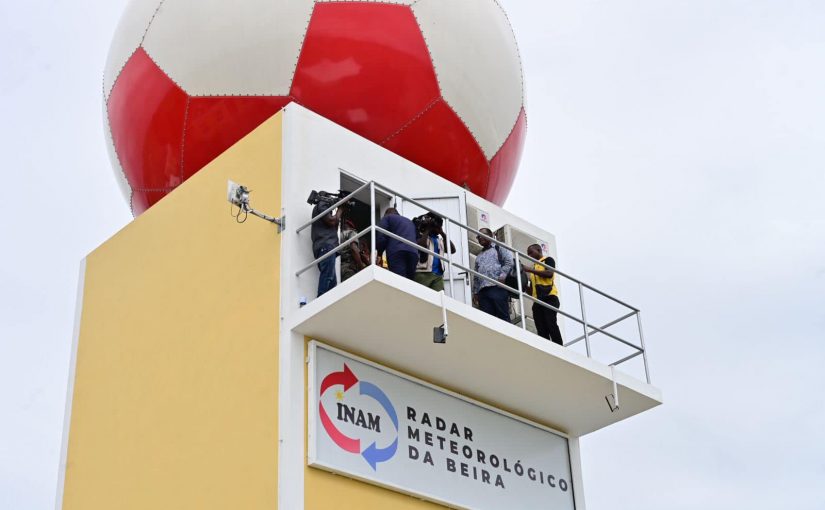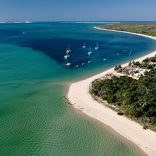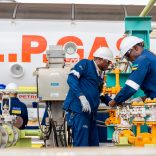Mozambique: Pioneer of biodiversity conservation Roberto Zolho passes away
Mozambique: Beira radar provides real-time detection of extreme weather events

Photo: Gabinete de Reconstrução Pós-Ciclones
- The installation of this radar in Mozambique, currently the only operational weather radar in the country, is of great importance, taking into account that the country is cyclically affected by cyclones and extreme meteorological phenomena due to its geographic location.
President Nyusi this Wednesday inaugurated in the city of Beira the first of seven meteorological radars being installed in the country with the aim of reinforcing, modernising and expanding information on the weather phenomena. The previous radar was destroyed by Cyclone Idai in March 2019.
”This radar responds to the need to consolidate post-disaster preparation and response mechanisms, with concrete actions to monitor extreme events during their occurrence, issuing alerts, as well as ensuring the capture and dissemination of information in real time,” President Nyusi said.
The construction of the new radar, budgeted at 130 million meticais, was made possible by the African Development Bank (AfDB), a strategic development partner, which made funds available under the IDAI Post-Cyclone Reconstruction Programme.
”This radar is an important contribution to the implementation of the Executive Action Plan on the Early Warnings For All Initiative, which was formally launched by the UN Secretary-General in November, 2022, at the high-level summit of world leaders of the 27th session of the Conference of the Parties to the UNFCCC (COP27) in Sharm El-Sheikh, of which we were a part,” the president highlighted.
Inauguramos hoje na Cidade da Beira, o Radar Meteorológico, no âmbito da Iniciativa Presidencial “Um Distrito, uma Estação Meteorológica”. Com esta iniciativa a Província de Sofala passa a ter em tempo real a sua situação meteorológica. Parabéns Sofala. pic.twitter.com/44uFafeSCV
— Presidente Filipe Nyusi (@filipe_nyusi) April 19, 2023
Mozambican company is the technological partner of the project
The Beira radar will facilitate the measurement and estimation of precipitation and the speed of progression of weather systems that can cause intense precipitation, as well as the monitoring of the watersheds of the Púnguè, Búzi and Zambezi rivers, improving the weather early warning system in central Mozambique.
Mozambican company TVSD is responsible for implementing and installing the radar and will also be responsible for maintaining it over the next five years, which reveals, in the words of its CEO, Sérgio da Costa, that the country “has the engineering and knowledge needed to ensure the success of this initiative, from architecture, civil engineering and complementary engineering”.
The company has a partnership with the manufacturer Vaisala, a Finnish company and a world leader in meteorological equipment technology. Vaisala manufactured the radar and has provided training and technical training to twenty National Institute of Meteorology (INAM) personnel covering how to operate with the radar and extract and interpret the information obtained.
The installation of this radar in Mozambique, currently the only operational weather radar in the country, is of great importance, taking into account that the country is cyclically affected by cyclones and extreme meteorological phenomena due to its geographic location. The equipment will allow prediction regarding the behaviour of these weather phenomena so that the population is warned in advance and the responsible bodies can organise themselves in order to minimise impacts such as those of Cyclone Idai.
For Sérgio da Costa, “the entry into operation of the weather radar in Beira marks a turning point in the way Mozambique faces one of the main challenges facing the world today: climate change. And, in this sense, looking at the main needs of the country, and specifically at the communities in the central zone. The existence of this type of equipment is essential to guarantee their safety and minimise damage and, fundamentally, human losses that are always of concern. We believe that projects like this are of crucial importance for the safety of the entire population along the coast of Mozambique, from north to south”.
“Real-time” tracking
Modern weather radars are mostly pulse-Doppler radars, capable of detecting the radial motion of a hydrometeorology system (mainly raindrops, ice crystals and hail) and also estimating the intensity of precipitation associated with their fall. The variables obtained can be analysed to determine the internal structure of rainclouds (e.g. thunderstorms) as well as the associated updraft, downdraft, convergent and rotational wind currents. From this analysis, the potential of severe weather to cause damage can be determined.
The equipment uses a system of electromagnetic waves to be able to measure the distance, direction, altitude and speed of objects, both static and moving, and is capable of monitoring vehicles, planes, ships, etc. In this case, the waves are used to assess meteorological formations and continuously monitor cloud movement. Its operation is quite simple: they generate a radio pulse that is reflected in the target, being received from the same position as the transmitter. Thanks to this, a set of information can be obtained about the location of the clouds, their density and shape, if they are growing or if they will cause some type of precipitation.
The radar will be operated by INAM from its control centre at Beira Airport and from its headquarters in the city of Maputo.
The official entities involved in this project are INAM, the Post-Cyclone Reconstruction Office (GREPOC) and the African Development Bank (AfDB), the latter responsible for financing.
The installation of the Beira radar is in line with the Sendai Framework for Disaster Risk Reduction 2015-2030, in particular target 7 of substantially increasing the availability of and access to multi-hazard early warning systems and disaster risk information and assessments by 2030.












Leave a Reply
Be the First to Comment!
You must be logged in to post a comment.
You must be logged in to post a comment.